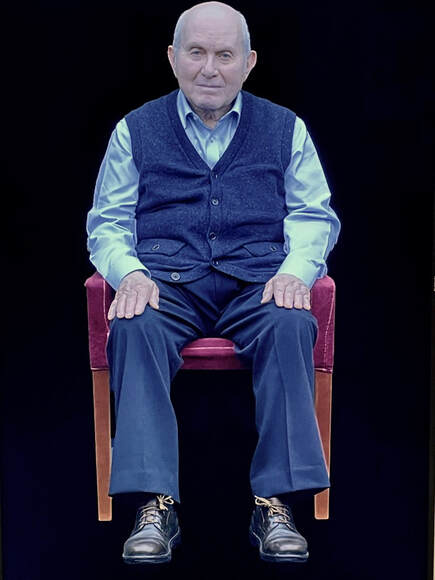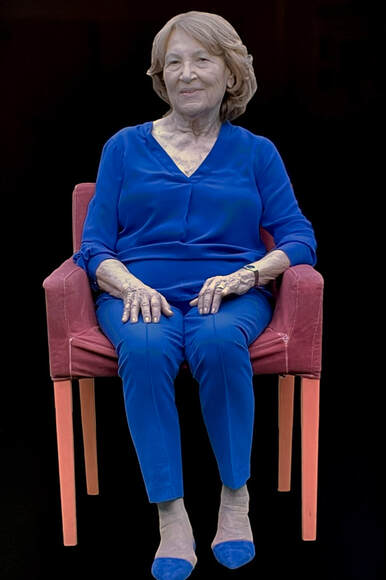Come Visit Our Virtual Holocaust Survivors. Interact with them. Ask them questions.
DIMENSIONS in TESTIMONY
MEET OUR TWO HOLOCAUST SURVIVORS :
Pinchas Gutter
Pinchas Gutter was born in Lódz, Poland on July 21, 1932. His parents were winemakers, until the war reached Lódz when Pinchas was 8. Just three weeks after the Nazi occupation of Lódz, Pinchas’ father was nearly beaten to death. The family fled to meet Pinchas’ aunt in Warsaw. There, they were held in the Warsaw Ghetto, where they remained through the Warsaw Ghetto Uprising of April 19, 1943. Prior to the uprising, Pinchas’ father had a bunker constructed to hide the Gutter family. They were discovered and sent to Majdanek concentration camp. In Majdanek, Pinchas’ parents and twin sister perished. Pinchas was selected for forced labor in Skarzysko Kamienna camp, then for work at Tschenstochau-Raków camp, and was after that transferred to Buchenwald in 1944. He continued to survive as a forced laborer in the kitchens of Colditz concentration camp in Germany, but was then sent on a death march toward the Theresienstadt Ghetto in Czechoslovakia. There, he was liberated by the Russian Army on May 8, 1945. After the war, Pinchas went to the United Kingdom, then moved to Paris to live with a cousin. He would later migrate to Israel, where he served in the military. There, he met and married his wife, Dorothy, with whom he moved to South Africa. Pinchas became a successful businessman and raised two daughters, Rumi and Tanya, as well as a son, Jan. In 1985, they moved to Toronto, Canada, where Pinchas continued his work as a financier. Today, he is retired, and volunteers as a cantor at his local synagogue.
Fritzie Fritzshall
Fritzie Fritzshall was born in 1929 in Klucharky, Czechoslovakia. After her town fell under Nazi occupation, Fritzie, her mother, and two brothers were deported to the Auschwitz – Birkenau extermination camp. She was only thirteen years old. Close to the end of the war, Fritzie was moved to a sub camp of Auschwitz where she worked as a slave laborer in a factory. In 1945, she was finally liberated by the Russian army, while on the death march from Auschwitz. After the war, in 1946, Fritzie came to the United States and was reunited with her father, who had been able to escape the Holocaust. Her mother, two younger brothers, and other family members all perished. Fritzie is an active member of the community, serving as President of the Illinois Holocaust Museum & Education Center. Fritzie continues to speak extensively on the local and state level about her experiences and lessons of the Holocaust. In 2015, Fritzie was awarded the Bertha Honoré Palmer Making History Award for Distinction in Civic Leadership from the Chicago History Museum.
The Marvel of Dimensions in Testimony
Years from now, Holocaust Survivor stories will survive, thanks to groundbreaking three-dimensional technology Dimensions in Testimony, developed by USC Shoah Foundation. The ability of visitors, including students and the general public, to interact with, and ask questions of a Holocaust Survivor for all future generations to learn from is both the wonder and the brilliance of this technology.
Dimensions in Testimony revolutionizes the concept of oral history by integrating advanced filming techniques, specialized display technologies and next-generation natural language processing to provide an intimate visitor experience. Each specially recorded interview enables visitors to ask questions of the survivor about their life experiences and hear responses in real-time, lifelike conversation. Questions are answered naturally, as if the survivor is in the room, and through Artificial Intelligence, the more questions asked the better the technology becomes.
To date, 19 interactive survivor biographies were captured using as many as 50 cameras with each survivor asked approximately 1,500 - 2,000 questions addressing topics ranging from pre-war life through the Holocaust and beyond. Each survivor spent several days in a Los Angeles studio answering these questions in. front of glaring lights and cameras in a green screen environment.
As seen on CBS 60 Minutes, visitors to the Craig and Barbara Weiner Holocaust Museum of South Florida can meet and interact with virtual Holocaust Survivors in order to learn of their deeply moving personal stories by asking your own individual questions and having a personalized, one-on-one ‘conversation.’
Here's a one minute clip from CBS 60 MINUTES
And another example from CNN
The Craig and Barbara Weiner Holocaust Museum of South Florida at Nova Southeastern University is currently the first and only location in the State of Florida hosting this extraordinary learning technology.
The Craig and Barbara Weiner Holocaust Museum
of South Florida
Alvin Sherman Library - Nova Southeastern University
Come visit us - 7 days a week - Never any charge !!
Dimensions in Testimony is an initiative by USC Shoah Foundation to record and display testimony in a way that will preserve the dialogue between Holocaust survivors and learners far into the future. Collaborating within the project are Illinois Holocaust Museum and Education Center, with technology by USC Institute for Creative Technologies, and concept by Conscience Display. Funding for Dimensions in Testimony was provided in part by Pears Foundation, Louis. F. Smith, Melinda Goldrich and Andrea Cayton/Goldrich Family Foundation in honor of Jona Goldrich, and Illinois Holocaust Museum and Education Center. Other partners include CANDLES Holocaust Museum and Education Center


